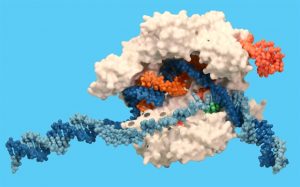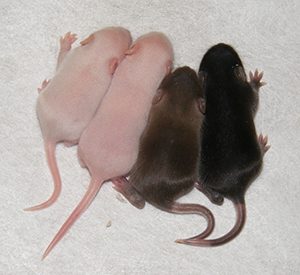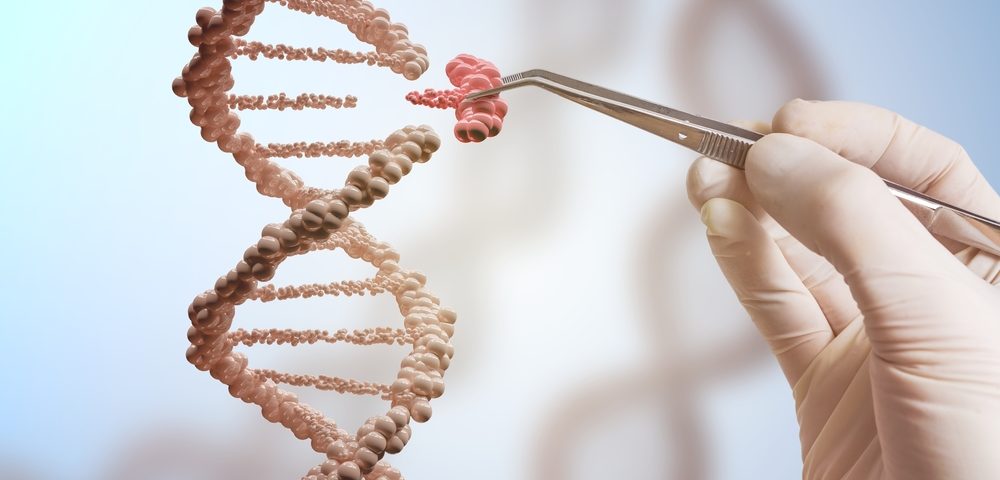CRISPR cas9 technology is a simple yet powerful invention for editing genomes. It allows researchers to easily alter DNA sequences and modify gene function. Its many potential applications include correcting genetic defects, treating and preventing the spread of diseases.
– The history of CRISPR invention:
CRISPR technology came about through a basic research project that was aimed at discovering how bacteria fight viral infections.
Bacteria have to deal with viruses in their environment, a bacterium has only a few minutes to defuse the bomb before it gets destroyed. So, many bacteria have in their cells an adaptive immune system called CRISPR, that allows them to detect viral DNA and destroy it.
- In 1987 a group of Japanese scientist discovered an odd DNA sequences in a type of bacteria called E.coli, this repeated sequences was something that had never been seen before they are palindromic (the sequence can be read identically forward and backward for example:
5’ – G A A T T C – 3’
3’ – C T TAA G – 5’
And separated by spaces that are not palindromic in nature none of the Japanese scientist were able to elucidate the purpose of these sequences.
- In 1990Francisco Mojica, University of Alicante, Spain found the same palindromic sequences in anther single cellular organism, called archea, Francisco decided to name the sequences (CRISPR) which stands for: Clustered Regularly Interspaced Short Palindromic Repeats.
He also decided to analyze each one of these interspaces by using a biochemichal analysis tool called a BLAST (Basic Local Alignment Search Tool is an algorithm for comparing primary biological sequence information, such as the amino-acid sequences of proteins or the nucleotides of DNA sequences), he found that these sequences indeed matched other DNA sequences of viruses, so he hypothesized that these spaces encoded an immune mechanism in the bacteria against viruses.
- In the early 2000s, Philippe Horvath and RodolpheBarrangou of Daniscoand their colleagues were first introduced to CRISPR while sequencing Streptococcus thermophilus, a workhorse of yogurt and cheese production. Initially, says Barrangou, they had no idea of the purpose of the CRISPR sequences. But as his group sequenced different strains of the bacteria, they began to realize that CRISPR might be related to phage infection and subsequent immune defense. “That was an eye-opening moment when we first thought of the link between CRISPR sequencing content and phage resistance,” says Barrangou In 2006 francisco hypothesis was approved by a scientist named Philip Horvath who assumed that the CRISPR is a bacterial adaptive immune system.
He also identified a gene repeat that is responsible for coding a protein enzyme called cas9 which is a helices enzyme that is responsible for cutting the viral DNA.
- One year later in August 2008, John Van der Oost,University of Wageningen, Netherlands was the first who created an artificial CRISPR array, so he can instruct the bacterial immune system against any virus, by this he recorded the first case of directly programmable CRISPR based immunity.
- Some years later in 2012 mmanuelleCharbentier, Umea University, Sweden established the full mechanism of CRISPR, she discovered the (tracrRNA) the last essential component of the CRISPR system.tracrRNA forms a duplex with crRNA, and that it is this duplex that guides Cas9 to its targets, now all the three component system of CRSPR is now known and the DISCOVERY WAS MADE!
“While CRISPR biology remains an active area of study, the memorable acronym is now more commonly associated with genome engineering than it is with prokaryotic adaptive immunity! “
– A brief explanation of CRISRP technology and how it works:
When viruses infect a cell, they inject their DNA inside the bacteria and in a bacterium, that DNAis plucked out of the virus and inserted in little bits into the chromosome”the DNA of the bacterium”. These integrated bits of viral DNA get inserted at a site called CRISPR. That’s why they used the acronym CRISPR. It’s a mechanism that allows cells to record, over time, the viruses they have been exposed to. And it isgood to mention that those bits of DNA are passed on to the cellsprogeny, so cells are protected from viruses not only in one generation, but over many generations of cells.
RNA from the CRISPR locus bind to protein called Cas9 and form a complex that functions like a sentinel in the cell It searches through all of the DNA in the cell, to find sites that match the sequences in the bound RNAs. And when those sites are found the complex associates with that DNA and allows the Cas9 cleaver to cut up the viral DNA. It makes a double-stranded break in the DNA helix. It is important to know that this complex is programmable, which means it can be programmed to recognize particular DNA sequences, and allow scientists to make a break in the DNA at that particular site.
This process could be harnessed for genome engineering, to allow cells to make a very precise change to the DNA at the site where this break was introduced. It is similar to the way that we use a word-processing program to fix a typo in a document!

The reason why scientists envisioned using the CRISPR system for genome engineering is because cells have the ability to detect broken DNA and repair it. So when an animal cell detects a double-stranded break in its DNA it can fix that break either by pasting together the ends of the broken DNA within the sequence of that position, or it can repair the break by integrating a new piece of DNA at the site of the cut. So if we have a way to introduce double-stranded breaks into DNA we can trigger cells to repair those breaks. As a result if we were able to program the CRISPR technology to make a break in DNA at the position or near a mutation we could trigger cells to repair that mutation.
As a proof of principle, the Genome Editing Core team targeted the mouse tryosinase gene, Spontaneous mutations exist in the tyrosinasegene that render the normally black mice into albino. By targeting tyrosinase, an observable phenotype appears even before the mice are old enough to be genotyped. The Core has already generated several albino mice from their first CRISPR injections, and when we sequence the DNA from these animals, we find that the change in the DNA has occurred at exactly the place where we induced it, using the CRISPR technology.
By targeting tyrosinase, an observable phenotype appears even before the mice are old enough to be genotyped. The Core has already generated several albino mice from their first CRISPR injections, and when we sequence the DNA from these animals, we find that the change in the DNA has occurred at exactly the place where we induced it, using the CRISPR technology.
“This technology raises a number of ethical questions that we have to carefully consider, and this is why I and my colleagues have called for a global pause in any clinical application of the CRISPR technology in human embryos, to give us time to really consider all of the various implications of doing so”, says the CRISPR co-developer Jennifer Doudna.
Some people may even think it important to use CRISPR to make better humans, not just preemptively stamp out disease. There are gene variants which confer extra-strong bones, low Alzheimer’s risk or viral resistance such as to HIV. Beyond that, what about enhancements such as living longer, improved cognition, or altered physical attributes? “I am sure there are broader human characteristics that people would like to be able to modulate,” says Dana Carroll. But he adds that presently those kind of multi-genetic traits would be difficult to edit in because we don’t fully understand their basis.
CRISPR–Cas9 may be democratizing gene editing in the laboratory, but Todd Kuiken, who studies science policy at the Wilson Center, Contrary to reports in the popular media, he says, few CRISPR creations are likely to come from the labs of do-it-yourself biologists any time soon.
However, this group is arguably ahead of the scientific establishment when it comes to thinking about how to use the technology safely. For better or for worse, CRISPR–Cas9 is transforming biology. We are now at the dawn of the gene-editing age.
For further readings you can visit:
https://www.broadinstitute.org/what-broad/areas-focus/project-spotlight/crispr-timeline
https://www.sciencedirect.com/science/article/pii/S0092867414006047
https://www.sciencedirect.com/science/article/pii/S1097276515001641
http://science.sciencemag.org/content/346/6213/1258096
https://www.livescience.com/58790-crispr-explained.html
https://www.nature.com/news/crispr-everywhere-1.19511
https://medicine.uiowa.edu/content/paradee-and-genome-editing-team-make-first-crispr-engineered-mouse-iowa
https://www.theguardian.com/science/2015/may/10/crispr-genome-editing-dna-upgrade-technology-genetic-disease
https://www.thescientist.com/?articles.view/articleNo/41676/title/There-s-CRISPR-in-Your-Yogurt
https://www.3dmoleculardesigns.com/Custom-3D-Print-Molecular-Models/CRISPR-Cas9.htm

